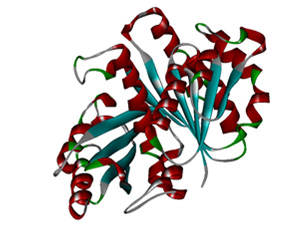
ここからコンテンツです。

Proposal for a new tuberculosis drug that does not mutate bacteria and does not cause drug resistance
In silico drug design using state-of-the-art high-precision molecular computer simulations By Noriyuki Kurita
The research team of the Department of Computer Science and Engineering at the Toyohashi University of Technology and the Institute of Food Biotechnology and Genomics at the National Academy of Sciences of Ukraine have proposed a new drug to treat tuberculosis (TB), utilizing state-of-the-art molecular simulations. This drug may inhibit the cell division of Mycobacterium tuberculosis (M. tuberculosis) and suppress its growth. In addition, because this drug acts on the enzymes secreted by M. tuberculosis rather than on M. tuberculosis itself, M. tuberculosis has very little chance of mutation and develops no drug resistance. Therefore, it is expected that this research will lead to a new drugs that should retain their effectiveness for a long time.
Currently, the global spread of COVID-19 caused by the novel coronavirus has become a major social issue. Similarly, TB caused by M. tuberculosis is also one of the most dangerous infectious diseases in the world to date, and various drugs used to treat TB have been developed. However, as the M. tuberculosis easily mutates, its new mutations can develop resistance to existing drugs, and thus rendering them ineffective. This fact is a major bottleneck to further development of TB drugs.
Therefore, to prevent the occurrence of this drug resistance, drugs that act on the enzymes secreted by M. tuberculosis instead of M. tuberculosis itself are being developed. In this research, we targeted the cytoskeletal protein FtsZ, which is essential for M. tuberculosis to perform cell division, and by inhibiting that function, we aimed to develop a new drug that inhibits the cell division of M. tuberculosis and suppresses its growth. For this purpose, we used the state-of-the-art and high-precision molecular simulation method developed by our research group to analyze the binding properties between FtsZ and the various compounds that are drug candidates. Based on the results simulated, we proposed a compound that binds more strongly to FtsZ as a new drug to treat TB.

Master’s student and lead author of this research paper, Shohei Yamamoto, reflects on that time below. "Because the FtsZ protein targeted in this research has many positions where compounds can bind to it, we had difficulty identifying the positions of the FtsZ protein in which the compounds considered as drug candidates would bind most strongly in the molecular simulation. I think that being able to solve this matter led to the proposal of a therapeutic drug for TB."
In addition, the research team’s leader, Associate Professor Noriyuki Kurita, recounts how the research began below. "This research is a collaboration with my old friends at the National Academy of Sciences of Ukraine. I remember about five years ago, when I visited a laboratory in Kyiv, Ukraine and was first introduced to a protein called FtsZ, my feeling then was that its structure was too complex to allow for investigation into its binding properties with drug-like compounds in our molecular simulations. However, my friends asked me several times to start the calculations, and finally our intimate collaboration study started. I think that Eastern European researchers tend to thoroughly pursue difficult research themes even if it takes a long time, and that there are many things that we could learn from how they proceed with their research."
Currently, we are requesting that the compound proposed in this research be synthesized in a Ukrainian laboratory and the effects be investigated by cell experiments, but due to the economic situation of the other party, it seems that this will take time to realize. In addition, the molecular simulation method used in this research can be applied to other proteins, and we are currently conducting calculations with the aim of proposing new inhibitors for the proteins of the novel coronavirus.
This research was carried out through an international internship program supported by the Japan Student Services Organization (JASSO), student exchange and research exchange programs between the Toyohashi University of Technology and the Institute of Food Biotechnology and Genomics at the National Academy of Sciences of Ukraine, and a joint research program. We would like to thank Professor Yaroslav Blume, Professor Sergey Shulga, and Doctor Karpov Pavel of the National Academy of Sciences of Ukraine for providing valuable information in advancing this joint research.
References
"Proposal of potent inhibitors for a bacterial cell division protein FtsZ: Molecular simulations based on molecular docking and ab initio molecular orbital calculations" , Yamamoto, S.; Saito, R.; Nakamura, S.; Sogawa, H.; Karpov, P.; Shulga, S.; Blume, Y.; Kurita, N., Antibiotics, 2020, 9, 846; doi:10.3390/antibiotics9120846.
"Binding sites of Zantrin inhibitors to the bacterial cell division protein FtsZ: molecular docking and ab initio molecular orbital calculations" , Sogawa, H.; Sato, R.; Suzuki, K.; Tomioka, S.; Shinzato, T.; Karpov, P.; Shulga, S.; Blume, Y.; Kurita, N., Chemical Physics, 2020, 530, 110603; doi:10.1016/j.chemphys.2019.110603.
結核菌を変異させず薬剤耐性も起こさない、新結核治療薬の提案
最先端の高精度分子コンピューシミュレーションを活用した創薬の研究By 栗田 典之
豊橋技術科学大学の情報・知能工学系とウクライナ国立科学アカデミーの食品バイオテクノロジー研究所の研究チームは、高精度分子シミュレーション手法を用い、結核に対する新規治療薬を提案しました。この治療薬は、結核菌の細胞分裂を阻害し、その増殖を抑制できる可能性があります。さらに、この薬は結核菌自体ではなく、結核菌が排出する酵素に作用するため、結核菌が変異し、薬に対して耐性を持ってしまう薬剤耐性も起こさず、その効果が長期間有効な薬になると期待できます。
現在、新型コロナウイルスによる感染症の世界的規模での拡大が、大きな社会問題となっていますが、結核菌による感染症も、これまで世界中で最も危険視された感染症の一つであり、結核に対する様々な治療薬が開発されて来ました。しかし、結核菌は容易に変異するため、これらの治療薬に対して耐性を持つ新たな結核菌が現れ、既存の治療薬が効かなくなることが問題となっています。
そこで、この薬剤耐性を生じさせないため、結核菌自体ではなく、結核菌が排出する酵素に作用する薬が開発されています。本研究では、結核菌が細胞分裂を行うために不可欠な細胞骨格タンパク質FtsZをターゲットとして、その機能を阻害することで、結核菌の細胞分裂を阻害し、結核菌の増殖を抑制する新しい治療薬の開発を目指しました。そのため、研究グループでこれまでに開発した高精度分子シミュレーション手法を用い、FtsZと薬の候補となる様々な化合物間の結合特性を解析し、FtsZにより強く結合する化合物を、結核に対する新規治療薬として提案しました。
今回の論文の筆頭著者である博士前期課程の山本昌平君は、以下のように、当時を振り返っています。「今回の研究でターゲットとしたFtsZというタンパク質は、化合物が結合できる位置が沢山存在するため、薬の候補として考えた化合物が、FtsZのどの位置に最も強く結合するかを、分子シミュレーションで明らかにすることに苦労しました。この点を解決できたことが、治療薬の提案に繋がったと思います。」
また、研究チームのリーダーである栗田典之准教授は、この研究が始まった経緯を、以下のように述べています。「この研究は、ウクライナ国立科学アカデミーに所属する古い友人との共同研究です。5年程前、ウクライナのキエフにある研究所を訪問し、FtsZというタンパク質を初めて紹介された時は、これは構造が複雑過ぎて、我々の分子シミュレーションでは計算困難であると回答しましたが、何度か先方から依頼され、計算を始めたことが思い出されます。東欧の研究者の多くは、時間がかかっても難しい研究テーマをじっくり進める傾向にあり、彼らの研究の進め方に見習う点が多いと思います。」
現在、この研究で提案した化合物を、ウクライナの研究室で合成し、細胞実験によりその影響を調べることを依頼していますが、先方の経済的状況もあり、実現まで時間がかかりそうな状況です。また、今回用いた分子シミュレーション手法は、他のタンパク質にも応用可能であり、現在、新型コロナウイルスが有するタンパク質に対する新規阻害剤の提案を目指して計算を進めています。
本研究は、日本学生支援機構(JASSO)の支援による国際インターンシッププログラム、豊橋技術科学大学とウクライナ国立科学アカデミーの食品バイオテクノロジー研究所間の学生交流、及び共同研究プログラムによって実施されました。この共同研究を進める上で、貴重な情報を提供して頂いたウクライナ国立科学アカデミーのYaroslav Blume教授、Sergey Shulga教授、Karpov Pavel博士に感謝致します。
Researcher Profile

| Name | Noriyuki Kurita |
|---|---|
| Affiliation | Department of Computer Science and Engineering |
| Title | Associate Professor |
| Fields of Research | Quantum Biology, Computational Science, Biological information Science |
ここでコンテンツ終わりです。
